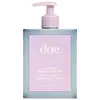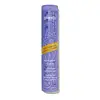What's inside
What's inside
 Key Ingredients
Key Ingredients

 Benefits
Benefits

 Concerns
Concerns

 Ingredients Side-by-side
Ingredients Side-by-side

Water
Skin ConditioningSodium Lauroyl Methyl Isethionate
CleansingSodium C14-16 Olefin Sulfonate
CleansingCocamidopropyl Betaine
CleansingSodium Cocoyl Isethionate
CleansingSodium Methyl Oleoyl Taurate
CleansingBetaine
HumectantAcrylates Copolymer
Citrus Aurantium Dulcis Peel Oil
MaskingParfum
MaskingHydrolyzed Quinoa
Skin ConditioningPhenoxyethanol
PreservativeCI 60730
Cosmetic ColorantLauryl Lactyl Lactate
Skin ConditioningSilicone Quaternium-3
Trisodium Ethylenediamine Disuccinate
Guar Hydroxypropyltrimonium Chloride
Skin ConditioningCaprylyl Glycol
EmollientGlycerin
HumectantChlorphenesin
AntimicrobialTrideceth-12
EmulsifyingMica
Cosmetic ColorantPolyquaternium-7
Tetrasodium Glutamate Diacetate
Butylene Glycol
HumectantTitanium Dioxide
Cosmetic ColorantCereus Grandiflorus Extract
AntioxidantCitrus Aurantifolia Fruit Extract
Skin ConditioningHibiscus Rosa-Sinensis Flower Extract
HumectantMoringa Oleifera Leaf Extract
Skin ConditioningAloe Barbadensis Leaf Juice
Skin ConditioningWater, Sodium Lauroyl Methyl Isethionate, Sodium C14-16 Olefin Sulfonate, Cocamidopropyl Betaine, Sodium Cocoyl Isethionate, Sodium Methyl Oleoyl Taurate, Betaine, Acrylates Copolymer, Citrus Aurantium Dulcis Peel Oil, Parfum, Hydrolyzed Quinoa, Phenoxyethanol, CI 60730, Lauryl Lactyl Lactate, Silicone Quaternium-3, Trisodium Ethylenediamine Disuccinate, Guar Hydroxypropyltrimonium Chloride, Caprylyl Glycol, Glycerin, Chlorphenesin, Trideceth-12, Mica, Polyquaternium-7, Tetrasodium Glutamate Diacetate, Butylene Glycol, Titanium Dioxide, Cereus Grandiflorus Extract, Citrus Aurantifolia Fruit Extract, Hibiscus Rosa-Sinensis Flower Extract, Moringa Oleifera Leaf Extract, Aloe Barbadensis Leaf Juice
Water
Skin ConditioningSodium C14-16 Olefin Sulfonate
CleansingCocamidopropyl Betaine
CleansingGlycerin
HumectantSodium Methyl Cocoyl Taurate
CleansingDisodium Cocoamphodiacetate
CleansingPEG-7 Glyceryl Cocoate
EmulsifyingGlyceryl Stearate
EmollientHippophae Rhamnoides Fruit/Seed Oil
AntimicrobialBorago Officinalis Seed Oil
EmollientPersea Gratissima Oil
Skin ConditioningMangifera Indica Seed Butter
Skin ConditioningButyrospermum Parkii Butter
Skin ConditioningHydroxypropyl Guar Hydroxypropyltrimonium Chloride
Lavandula Angustifolia Flower Extract
CleansingChamomilla Recutita Flower Extract
MaskingRosmarinus Officinalis Leaf Extract
AntimicrobialHydrolyzed Quinoa
Skin ConditioningAminomethyl Propanol
BufferingBis-PCA Dimethicone
Butylene Glycol
HumectantDisodium EDTA
Disodium PEG-12 Dimethicone Sulfosuccinate
CleansingPEG-55 Propylene Glycol Oleate
PEG-12 Dimethicone
Skin ConditioningPEG-150 Distearate
EmulsifyingPEG-150 Stearate
Polyquaternium-10
Polyquaternium-7
Polysorbate 20
EmulsifyingPropylene Glycol
HumectantPolyethylene
AbrasiveGlycol
HumectantCitric Acid
BufferingDehydroacetic Acid
PreservativeBenzyl Alcohol
PerfumingPhenoxyethanol
PreservativePotassium Sorbate
PreservativeSodium Benzoate
MaskingBenzoic Acid
MaskingStearic Acid
CleansingSodium Chloride
MaskingParfum
MaskingBenzyl Benzoate
AntimicrobialHydroxycitronellal
PerfumingLimonene
PerfumingCI 60730
Cosmetic ColorantWater, Sodium C14-16 Olefin Sulfonate, Cocamidopropyl Betaine, Glycerin, Sodium Methyl Cocoyl Taurate, Disodium Cocoamphodiacetate, PEG-7 Glyceryl Cocoate, Glyceryl Stearate, Hippophae Rhamnoides Fruit/Seed Oil, Borago Officinalis Seed Oil, Persea Gratissima Oil, Mangifera Indica Seed Butter, Butyrospermum Parkii Butter, Hydroxypropyl Guar Hydroxypropyltrimonium Chloride, Lavandula Angustifolia Flower Extract, Chamomilla Recutita Flower Extract, Rosmarinus Officinalis Leaf Extract, Hydrolyzed Quinoa, Aminomethyl Propanol, Bis-PCA Dimethicone, Butylene Glycol, Disodium EDTA, Disodium PEG-12 Dimethicone Sulfosuccinate, PEG-55 Propylene Glycol Oleate, PEG-12 Dimethicone, PEG-150 Distearate, PEG-150 Stearate, Polyquaternium-10, Polyquaternium-7, Polysorbate 20, Propylene Glycol, Polyethylene, Glycol, Citric Acid, Dehydroacetic Acid, Benzyl Alcohol, Phenoxyethanol, Potassium Sorbate, Sodium Benzoate, Benzoic Acid, Stearic Acid, Sodium Chloride, Parfum, Benzyl Benzoate, Hydroxycitronellal, Limonene, CI 60730
Ingredients Explained
These ingredients are found in both products.
Ingredients higher up in an ingredient list are typically present in a larger amount.
Butylene Glycol (or BG) is used within cosmetic products for a few different reasons:
Overall, Butylene Glycol is a safe and well-rounded ingredient that works well with other ingredients.
Though this ingredient works well with most skin types, some people with sensitive skin may experience a reaction such as allergic rashes, closed comedones, or itchiness.
Learn more about Butylene GlycolThis ingredient is a purple dye. It is also known as Violet No. 2 or Acid Violet 43 and is a synthetic dye derived from coal tar.
According to a manufacturer, this dye it known for its intense color saturation and resistance to fading.
Cocamidopropyl Betaine is a fatty acid created by mixing similar compounds in coconut oil and dimethylaminopropylamine, a compound with two amino groups.
This ingredient is a surfactant and cleanser. It helps gather the dirt, pollutants, and other impurities in your skin to be washed away. It also helps thicken a product and make the texture more creamy.
Being created from coconut oil means Cocamidopropyl Betaine is hydrating for the skin.
While Cocamidopropyl Betaine was believed to be an allergen, a study from 2012 disproved this. It found two compounds in unpure Cocamidopropyl Betaine to be the irritants: aminoamide and 3-dimethylaminopropylamine. High-grade and pure Cocamidopropyl Betaine did not induce allergic reactions during this study.
Learn more about Cocamidopropyl BetaineGlycerin is already naturally found in your skin. It helps moisturize and protect your skin.
A study from 2016 found glycerin to be more effective as a humectant than AHAs and hyaluronic acid.
As a humectant, it helps the skin stay hydrated by pulling moisture to your skin. The low molecular weight of glycerin allows it to pull moisture into the deeper layers of your skin.
Hydrated skin improves your skin barrier; Your skin barrier helps protect against irritants and bacteria.
Glycerin has also been found to have antimicrobial and antiviral properties. Due to these properties, glycerin is often used in wound and burn treatments.
In cosmetics, glycerin is usually derived from plants such as soybean or palm. However, it can also be sourced from animals, such as tallow or animal fat.
This ingredient is organic, colorless, odorless, and non-toxic.
Glycerin is the name for this ingredient in American English. British English uses Glycerol/Glycerine.
Learn more about GlycerinWe don't have a description for Hydrolyzed Quinoa yet.
Parfum is a catch-all term for an ingredient or more that is used to give a scent to products.
Also called "fragrance", this ingredient can be a blend of hundreds of chemicals or plant oils. This means every product with "fragrance" or "parfum" in the ingredients list is a different mixture.
For instance, Habanolide is a proprietary trade name for a specific aroma chemical. When used as a fragrance ingredient in cosmetics, most aroma chemicals fall under the broad labeling category of “FRAGRANCE” or “PARFUM” according to EU and US regulations.
The term 'parfum' or 'fragrance' is not regulated in many countries. In many cases, it is up to the brand to define this term.
For instance, many brands choose to label themselves as "fragrance-free" because they are not using synthetic fragrances. However, their products may still contain ingredients such as essential oils that are considered a fragrance by INCI standards.
One example is Calendula flower extract. Calendula is an essential oil that still imparts a scent or 'fragrance'.
Depending on the blend, the ingredients in the mixture can cause allergies and sensitivities on the skin. Some ingredients that are known EU allergens include linalool and citronellol.
Parfum can also be used to mask or cover an unpleasant scent.
The bottom line is: not all fragrances/parfum/ingredients are created equally. If you are worried about fragrances, we recommend taking a closer look at an ingredient. And of course, we always recommend speaking with a professional.
Learn more about ParfumPhenoxyethanol is a preservative that has germicide, antimicrobial, and aromatic properties. Studies show that phenoxyethanol can prevent microbial growth. By itself, it has a scent that is similar to that of a rose.
It's often used in formulations along with Caprylyl Glycol to preserve the shelf life of products.
Polyquaternium-7 is a light to clear colored liquid. It is commonly found in haircare products for its film-forming and anti-static properties.
According to a manufacturer, it is a non-paraben and specially developed for negatively charged surfactant systems. This makes it a great hairstyle holder and helps to improve wet hair detangling without adding buildup.
Sodium C14-16 Olefin Sulfonate is a cleansing agent made from a mixture of long chain sulfonate salts. It can also help produce foam.
This ingredient may be drying. We recommend speaking with a professional if you have concerns.
Water. It's the most common cosmetic ingredient of all. You'll usually see it at the top of ingredient lists, meaning that it makes up the largest part of the product.
So why is it so popular? Water most often acts as a solvent - this means that it helps dissolve other ingredients into the formulation.
You'll also recognize water as that liquid we all need to stay alive. If you see this, drink a glass of water. Stay hydrated!
Learn more about Water